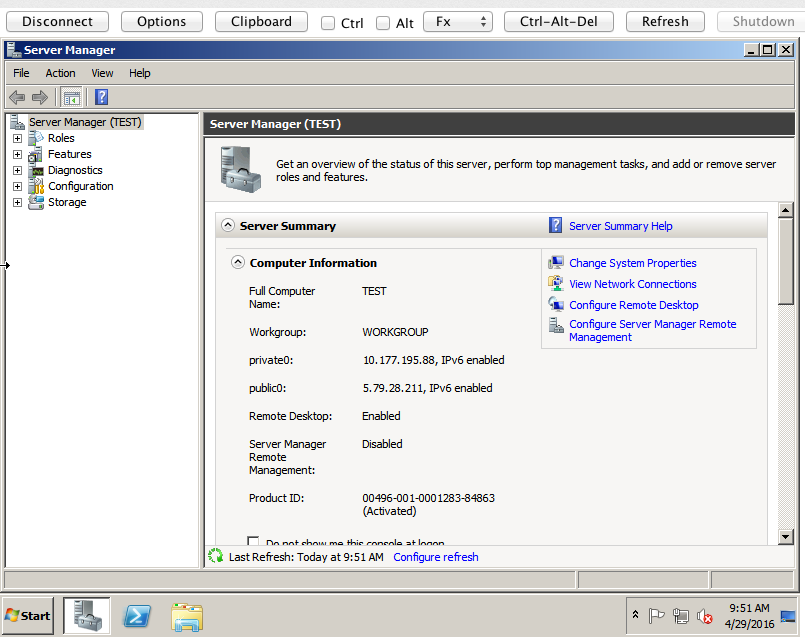Hey!
So I wrote a piece of software (basic) using BASh which exports Rackspace Cloud Servers between regions. It’s pure API CALLS using curl and I’m particularly proud of this piece, since it only took a day. (once I spent the whole of the next day figuring out an issue with the JSON and bash expansion for parameters to export the cloud server image to cloud files).
This is a super rough example of an automation-in-progress for cloud-servers between regions. Once you’ve set the script up, you simply change the serverid, and the script can do the rest, and you can migrate server by server, or perform batch migrates with this.
I’m going to refactor and rewrite it when I have time, but for now, here you are! Enjoy 😀
I hope that this is useful to people, particularly our customers.. when I release a finely tuned version that has commandline arguments support.
#!/bin/bash
USERNAME=''
APIKEY=''
API_ENDPOINT='https://lon.servers.api.rackspacecloud.com/v2/100101010'
SERVER_ID='cd2b545b-99d4-42c1-a881-4714f4bf4b92'
TENANT='100101010'
TOKEN=`curl https://identity.api.rackspacecloud.com/v2.0/tokens -X POST -d '{ "auth":{"RAX-KSKEY:apiKeyCredentials": { "username":"'$USERNAME'", "apiKey": "'$APIKEY'" }} }' -H "Content-type: application/json" | python -mjson.tool | grep -A5 token | grep id | cut -d '"' -f4`
# START IMAGE CREATION
echo "Creating Image at Local Datacentre"
curl -v -D export-headers \
-H "X-Auth-Token: $TOKEN" \
-H "Accept: application/json" \
-H "content-type: application/json" \
-d '{"createImage" : {"name" : "RA-'$SERVER_ID'", "metadata": { "ImageType": "Rackspace Automation Image Exported from '$TENANT'", "ImageVersion": "2.0"}}}' \
-X POST "$API_ENDPOINT/servers/$SERVER_ID/action" > export-headers
echo "export headers"
cat export-headers
# Retrieve correct ImageID and use to check status of image
IMAGEID=$(cat export-headers | grep -i location | sed 's/\// /g' | awk '{print $7}')
sleep 5
echo "image id"
echo $IMAGEID
API_ENDPOINT='https://lon.images.api.rackspacecloud.com/v2/images/'
URL=$API_ENDPOINT$IMAGEID
URL=${URL%$'\r'}
curl -v \
-H "X-Auth-Token: $TOKEN" \
-H "X-Project-Id: 100101010" \
-H "Accept: application/json" \
-H "content-type: application/json" \
-X GET "$URL" | python -mjson.tool > imagestatus
echo "imagestatus: $imagestatus"
STATUS=$(cat imagestatus | grep status | awk '{print $2}' | sed 's/"//g' | sed 's/,//g')
## WAIT FOR IMAGE TO EXIT SAVE STATE
echo "Waiting for image to complete..."
sleep 5
while [ "$STATUS" != "active" ]; do
echo "image $IMAGEID is still saving..."
sleep 10
curl -s \
-H "X-Auth-Token: $TOKEN" \
-H "X-Project-Id: 100101010" \
-H "Accept: application/json" \
-H "content-type: application/json" \
-X GET "$URL" | python -mjson.tool > imagestatus
STATUS=$(cat imagestatus | grep status | awk '{print $2}' | sed 's/"//g' | sed 's/,//g')
done
## PREPARE/CREATE CLOUD FILES CONTAINER for EXPORT
echo "Preparing/Creating Cloud Files Container for Export"
API_ENDPOINT='https://storage101.lon3.clouddrive.com/v1/MossoCloudFS_100101010'
curl -v -s \
-H "X-Auth-Token: $TOKEN" \
-H "X-Project-Id: 100101010" \
-H "Accept: application/json" \
-X PUT "$API_ENDPOINT/export"
sleep 5
## EXPORT VHD TO CLOUD FILES
echo "Exporting VHD to Cloud Files"
# This section simply retrieves the TOKEN
TOKEN=`curl https://identity.api.rackspacecloud.com/v2.0/tokens -X POST -d '{ "auth":{"RAX-KSKEY:apiKeyCredentials": { "username":"'$USERNAME'", "apiKey": "'$APIKEY'" }} }' -H "Content-type: application/json" | python -mjson.tool | grep -A5 token | grep id | cut -d '"' -f4`
echo "IMAGEID detected as $IMAGEID"
# This section requests the Glance API to copy the cloud server image uuid to a cloud files container called export
# > export-cloudfiles
echo "THE IMAGE ID IS: $IMAGEID"
IMAGEID=${IMAGEID%$'\r'}
curl -v "https://lon.images.api.rackspacecloud.com/v2/$TENANT/tasks" -X POST -H "X-Auth-Token: $TOKEN" -H "Content-Type: application/json" -d '{"type": "export", "input": {"image_uuid": "'$IMAGEID'" , "receiving_swift_container": "export"}}' -o export-cloudfiles
echo "Export looks like"
cat export-cloudfiles
sleep 15
echo "export cloud-files looks like:"
cat export-cloudfiles
TASKID_EXPORT=$(cat export-cloudfiles | python -mjson.tool | grep '"id"' | awk '{print $2}' | sed 's/"//g' | sed 's/,//g')
echo "task ID export looks like"
echo "$TASKID_EXPORT"
API_ENDPOINT='https://storage101.lon3.clouddrive.com/v1/MossoCloudFS_100101010'
sleep 15
echo "Waiting for Task to complete..."
## WAIT FOR TASKID EXPORT TO COMPLETE TO CLOUD FILES
# This section simply retrieves the TOKEN
TOKEN=`curl https://identity.api.rackspacecloud.com/v2.0/tokens -X POST -d '{ "auth":{"RAX-KSKEY:apiKeyCredentials": { "username":"'$USERNAME'", "apiKey": "'$APIKEY'" }} }' -H "Content-type: application/json" | python -mjson.tool | grep -A5 token | grep id | cut -d '"' -f4`
# This section requests the Glance API to copy the cloud server image uuid to a cloud files container called export
curl "https://lon.images.api.rackspacecloud.com/v2/10101010/tasks/$TASKID_EXPORT" -X GET -H "X-Auth-Token: $TOKEN" -H "Content-Type: application/json" | python -mjson.tool > export-status
EXPORT_STATUS=$(cat export-status | grep status | awk '{print $2}' | sed 's/"//g' | sed 's/,//g')
while [ "$EXPORT_STATUS" = "processing" ]; do
sleep 15
curl "https://lon.images.api.rackspacecloud.com/v2/100101010/tasks/$TASKID_EXPORT" -X GET -H "X-Auth-Token: $TOKEN" -H "Content-Type: application/json" | python -mjson.tool > export-status
EXPORT_STATUS=$(cat export-status | grep status | awk '{print $2}' | sed 's/"//g' | sed 's/,//g')
done
# SET CORRECT CLOUD FILES NAME
CLOUD_FILES_NAME=$(cat export-cloudfiles | python -mjson.tool | grep image_uuid | awk '{print $2}' | sed 's/,//g' | sed 's/"//g')
## Download VHD Cloud from Cloud Files to this server
API_ENDPOINT='https://storage101.lon3.clouddrive.com/v1/MossoCloudFS_10101010'
# GET FILE FROM SOURCE CLOUD FILES
URL="$API_ENDPOINT/export/$CLOUD_FILES_NAME.vhd"
URL=${URL%$'\r'}
curl -s \
-H "X-Auth-Token: $TOKEN" \
-H "X-Project-Id: $TENANT" \
-H "Accept: application/json" \
-X GET "$API_ENDPOINT/export/$CLOUD_FILES_NAME.vhd" > $CLOUD_FILES_NAME.vhd
## NEW API USER/PASS REQUIRED FOR 2ND REGION
USERNAME=''
APIKEY=''
## Now for uploading the VHD to Cloud Files to Destination REGION
API_ENDPOINT='https://storage101.ord1.clouddrive.com/v1/MossoCloudFS_891671'
TOKEN=`curl https://identity.api.rackspacecloud.com/v2.0/tokens -X POST -d '{ "auth":{"RAX-KSKEY:apiKeyCredentials": { "username":"'$USERNAME'", "apiKey": "'$APIKEY'" }} }' -H "Content-type: application/json" | python -mjson.tool | grep -A5 token | grep id | cut -d '"' -f4`
curl -v -s \
-H "X-Auth-Token: $TOKEN" \
-H "X-Project-Id: 891671" \
-H "Accept: application/json" \
-X PUT "$API_ENDPOINT/import"
## Upload VHD Image to Cloud Files destination for import
curl -v -s \
-H "X-Auth-Token: $TOKEN" \
-H "X-Project-Id: 891671" \
-H "Accept: application/json" \
-X PUT "$API_ENDPOINT/import/$CLOUD_FILES_NAME.vhd" -T "$CLOUD_FILES_NAME.vhd"

